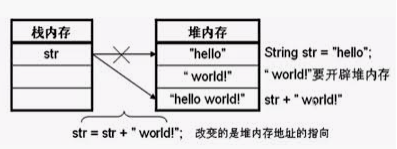String
String类是不可变类,即一旦一个String对象被创建以后,包含在这个对象中的字符序列是不可改变的,直至这个对象被销毁。

详细解释:
有两种情况:
- 如果你是String a = “aaa”; a = a + “bbb”,则会根据你字符串常量池是否有"aaabbb",有就不会新建,a存在栈中,作为引用,指向那个已经存在字符常量池里面的"aaa",没有就会在字符串常量池新生成一个"aaabbb".
- 如果你是String x = new String(“aaa”); 首先会在堆中生成一个new String(“aaa”)对象,然后还是根据你字符串常量池是否有"aaa",如果有则堆中只会创建一个new String(“aaa”)对象,如果没有则会在字符串常量池创建"aaa",然后拷贝一份到堆中,所以堆中总共创建了两个对象。所以这种情况可能是生成一个,也可能是生成2个。
如果有错恳求指正,勿喷,谢谢。
StringBuffer (线程安全)
StringBuffer对象是一个字符序列可变的字符串,它没有重新生成一个对象,而且在原来的对象中可以连接新的字符串。
StringBuffer对象则代表一个字符序列可变的字符串,当一个StringBuffer被创建以后,通过StringBuffer提供的append()、insert()、reverse()、setCharAt()、setLength()等方法可以改变这个字符串对象的字符序列。一旦通过StringBuffer生成了最终想要的字符串,就可以调用它的toString()方法将其转换为一个String对象。
StringBuilder
StringBuilder类也代表可变字符串对象。实际上,StringBuilder和StringBuffer基本相似,两个类的构造器和方法也基本相同。不同的是:StringBuffer是线程安全的,而StringBuilder则没有实现线程安全功能,所以性能略高。
三者继承结构

三者的区别:
(1)字符修改上的区别(主要)
String:不可变字符串;
StringBuffer:可变字符串、效率低、线程安全;
StringBuilder:可变字符序列、效率高、线程不安全;
(2)初始化上的区别,String可以空赋值,后者不行,报错
①String
StringBuffer s = null;
StringBuffer s = “abc”;
②StringBuffer
StringBuffer s = null; //结果警告:Null pointer access: The variable result can only be null at this location
StringBuffer s = new StringBuffer();//StringBuffer对象是一个空的对象
StringBuffer s = new StringBuffer(“abc”);//创建带有内容的StringBuffer对象,对象的内容就是字符串”
小结:(1)如果要操作少量的数据用 String;
(2)多线程操作字符串缓冲区下操作大量数据 StringBuffer;
(3)单线程操作字符串缓冲区下操作大量数据 StringBuilder(推荐使用)。
总结表格:
| String | StringBuffer | StringBuilder |
|---|---|---|
| String的值是不可变的,这就导致每次对String的操作都会生成新的String对象,不仅效率低下,而且浪费大量优先的内存空间 | StringBuffer是可变类,和线程安全的字符串操作类,任何对它指向的字符串的操作都不会产生新的对象。每个StringBuffer对象都有一定的缓冲区容量,当字符串大小没有超过容量时,不会分配新的容量,当字符串大小超过容量时,会自动增加容量 | 可变类,速度更快 |
| 不可变 | 可变 | 可变 |
| 线程安全 | 线程不安全 | |
| 多线程操作字符串 | 单线程操作字符串 |
继续深入
String 源码注释

Stirng类表示字符串。所有 Java程序中的字符串,例如{@code “abc”},是作为该类的实例实现。
字符串是常量;它们的值在它们之后不能改变,创建。字符串缓冲区支持可变字符串。因为字符串对象是不可变的,它们可以被共享
StringBuffer

由上可以看出 StringBuffer 通过了synchronized关键字保证了线程的安全性,但是效率会降低,又由于StringBuffer不需要重新开辟新的空间进行重新指向等一系列操作,提高了IO的处理速度,比String快,但是在单机并发量不高的情况下,StringBuffer又因为是线程安全的所以处理速度会有所降低。
StringBuilder

StringBuilder提供了String的可变性,提供了内存的处理速度,相比StringBuilder去掉了synchronized关键字,提升了效率,降低了高并发时的安全性。
随便写写 可以不看
AbstractStringBuilder 为 StringBuffer的父类
StringBuffer调用父类的方法
public synchronized StringBuffer append(StringBuffer sb) {
toStringCache = null;
super.append(sb);
return this;
}
AbstractStringBuilder 中的方法
// Documentation in subclasses because of synchro difference
public AbstractStringBuilder append(StringBuffer sb) {
if (sb == null)
return appendNull();
int len = sb.length();
ensureCapacityInternal(count + len);
sb.getChars(0, len, value, count);
count += len;
return this;
}
// Documentation in subclasses because of synchro difference
public AbstractStringBuilder append(StringBuffer sb) {
if (sb == null)
return appendNull();
int len = sb.length();
ensureCapacityInternal(count + len); //第一个方法
sb.getChars(0, len, value, count); // 主要看第二个方法
count += len;
return this;
}
/**
* For positive values of {@code minimumCapacity}, this method
* behaves like {@code ensureCapacity}, however it is never
* synchronized.
* If {@code minimumCapacity} is non positive due to numeric
* overflow, this method throws {@code OutOfMemoryError}.
*/
private void ensureCapacityInternal(int minimumCapacity) {
// overflow-conscious code
if (minimumCapacity - value.length > 0) {
value = Arrays.copyOf(value,
newCapacity(minimumCapacity));
}
}
// 》》 sb.getChars(0, len, value, count); // 主要看第二个方法
// 调用StringBuffer 中的方法,又通过Super()返回本类中调用
/**
* Characters are copied from this sequence into the
* destination character array {@code dst}. The first character to
* be copied is at index {@code srcBegin}; the last character to
* be copied is at index {@code srcEnd-1}. The total number of
* characters to be copied is {@code srcEnd-srcBegin}. The
* characters are copied into the subarray of {@code dst} starting
* at index {@code dstBegin} and ending at index:
* <pre>{@code
* dstbegin + (srcEnd-srcBegin) - 1
* }</pre>
*
* @param srcBegin start copying at this offset.
* @param srcEnd stop copying at this offset.
* @param dst the array to copy the data into.
* @param dstBegin offset into {@code dst}.
* @throws IndexOutOfBoundsException if any of the following is true:
* <ul>
* <li>{@code srcBegin} is negative
* <li>{@code dstBegin} is negative
* <li>the {@code srcBegin} argument is greater than
* the {@code srcEnd} argument.
* <li>{@code srcEnd} is greater than
* {@code this.length()}.
* <li>{@code dstBegin+srcEnd-srcBegin} is greater than
* {@code dst.length}
* </ul>
*/
public void getChars(int srcBegin, int srcEnd, char[] dst, int dstBegin)
{
if (srcBegin < 0)
throw new StringIndexOutOfBoundsException(srcBegin);
if ((srcEnd < 0) || (srcEnd > count))
throw new StringIndexOutOfBoundsException(srcEnd);
if (srcBegin > srcEnd)
throw new StringIndexOutOfBoundsException("srcBegin > srcEnd");
System.arraycopy(value, srcBegin, dst, dstBegin, srcEnd - srcBegin);
}





















 328
328











 被折叠的 条评论
为什么被折叠?
被折叠的 条评论
为什么被折叠?








